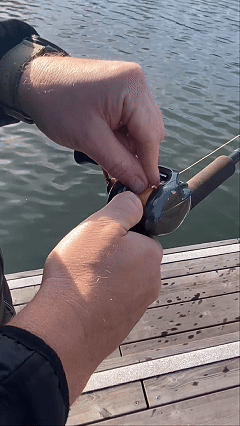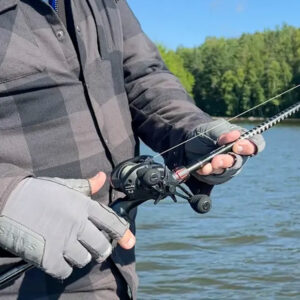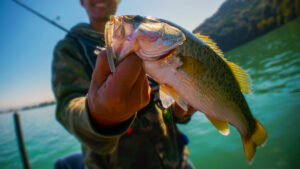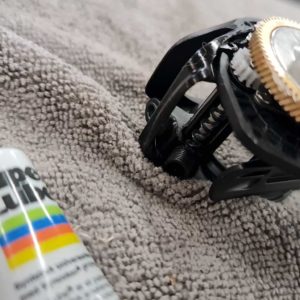What Is a Backlash (a.k.a. Bird’s Nest or Professional Overrun)?
Let’s be honest – every baitcaster user has faced the dreaded backlash. It’s when your spool spins faster than your line can handle, creating a tangled mess that looks like a bird built a nest in your reel.
Pro anglers like to call it a “professional overrun” – because even the best of the best aren’t immune. But whether you’re a weekend warrior or a tournament-level caster, this guide will help you fix, untangle, and prevent backlashes like a pro.
🧵 How to Fix a Baitcaster Backlash Like a Pro (Step-by-Step)
1. Assess the Nest
- Engage thumb bar; inspect spool for loose loops (tag ends) wrapping the main line.
- Flip rod tip up; gently pull 5-10 yards of line (if possible) to expose the tangle.
- All lines: Don’t yank or pull hard at it risks knotting deeper.
2. Tighten Drag and Thumb-Press Reel
- Crank drag knob clockwise (loosen later).
- Press thumb firmly on spool; reel slowly – this forces tag ends outward.
- Mono: Stretch aids untangling; effective for mild nests.
- Fluoro: Works well but check for kinks – low stretch snaps weak spots easily.
- Braid: Less effective; braid digs in. Skip for severe cases.
3. Untangle Tag Ends
- Isolate loops; tease free with fingers or tools.
- Mono: Finger-pull; memory (coils) may need straightening.
- Fluoro: Use needle-nose pliers – stiffness resists but kinks weaken line (cut damaged sections).
- Braid: Try pulling loops with your fingers and pull out line. Repeat until all loops are untangled. Use tweezers for bad tangles and precision but be careful to not damage the line.
4. Clear, Inspect, and Test
- Reel all slack; scan for hidden loops.
- Cast-test: Short tosses first; recast minor nests to self-clear (pro move).
- All lines: Discard >10-20% damaged line; re-spool if frequent.
Pro Tips to Avoid Line Tangles
🎯 Setup Mastery
- Match spool tension to your lure: open the thumb bar and let the lure fall. It should drop 6 inches steadily and stop.
- Use maximum brakes in wind or with light lures. Dial them down for longer casts in calm conditions.
🧵 Line Strategies
- Beginners: Use monofilament – it’s cheap and forgiving.
- Fluorocarbon: Best used as a leader to avoid deep kinks.
- Braid: Add a mono or electrical tape backing to prevent deep nesting. Pro tip: peel off ~75 yards, tape the spool, and rewind.
💪 Casting Technique
- Use a full arm snap, not a wrist flick.
- Feather the spool with your thumb as the lure descends.
- Practice 10–15 minutes daily in a calm yard with a ½ oz casting weight.
- Read more on baitcaster casting technique
Check out this Pro tip from TylersReelFishing on how to stop backlashes (the hard way).
🧠 Braking Systems: What You Need to Know
Your baitcaster’s braking system is your first line of defense against backlashes. Here’s how the main types work and what to watch out for:
🌀 Centrifugal Brakes
These use internal pins that press outward as the spool spins. The faster the spool, the more braking force is applied.
- ✅ Best for: Consistent braking throughout the cast
- ⚠️ Watch out for: Requires opening the reel to adjust pins manually
- 🧠 Pro Tip: Combine with proper spool tension and thumb control to maintain casting distance and avoid over-braking
🧲 Magnetic Brakes
These use magnets to slow the spool via magnetic resistance (Eddy Current). Adjustments are made externally with a dial.
- ✅ Best for: Easy on-the-fly adjustments
- ⚠️ Watch out for: Less effective at low spool speeds
- 🧠 Pro Tip: Use in moderate wind or when switching lure weights frequently. Still requires spool tension and thumb finesse for optimal performance
💻 Digital Control Brakes (DC)
These use microprocessors to monitor spool speed and apply braking electronically.
- ✅ Best for: Automatic adjustments and minimal backlash
- ⚠️ Watch out for: May require charging and could be sensitive to moisture
- 🧠 Pro Tip: While DC brakes offer advanced control, they do not replace spool tension or thumb control. For maximum casting distance and accuracy, you still need to fine-tune your tension knob and use your thumb to feather the spool at the end of the cast
🛡️ Svivlo CastGuard™: The Mechanical Marvel
Unlike traditional systems, Svivlo’s CastGuard™ is a fully mechanical, self-adjusting brake that reacts in real time—no batteries, no dials, no guesswork.
- 🔧 How it works: CastGuard™ senses spool deceleration and applies braking only when needed
- 🎯 Why it’s better:
- No manual tuning
- Works with all lure weights
- Performs flawlessly in wind and tough conditions
- Has enough brake force throughout the cast
- No electronics = better for the environment
🚫 Say Goodbye to Backlashes with Svivlo CastGuard™
What if we told you there’s a way to eliminate backlashes altogether?
Enter Svivlo’s CastGuard™ technology – a game-changer in the world of baitcasting. Unlike traditional reels that rely on magnetic or centrifugal brakes, Svivlo’s CastGuard™ uses a mechanical, automatic braking system that adapts in real-time to your casting speed and ever changing conditions.
🔧 How It Works:
- No manual adjustments needed – CastGuard™ senses spool speed and applies braking only when necessary.
- No batteries or electronics – just pure mechanical precision.
- Backlash-free casting – even in windy conditions or with lightweight lures.
Whether you’re flipping jigs for bass or bombing casts for pike, Svivlo reels with CastGuard™ let you focus on fishing, not fixing.
🎁 Ready to Fish Smarter?
Don’t let backlashes ruin your day on the water. Master the art of picking them out, follow best practices to avoid them, and upgrade to a https://svivlo.com for a truly backlash-free experience.
👉 Explore our full range of reels and accessories
👉 Read more tips on Mastering the Cast
👉 How does CastGuard™ compare to Shimano DC












